XFX Type 01 Bravo Case Review
by E. Fylladitakis on May 16, 2014 6:00 AM EST- Posted in
- Cases/Cooling/PSUs
- XFX
- mid-tower
- Case
Test Setup
Professional testing requires the emulation of real-world situations but with repeatable results; thus, a perfectly controllable test setup and environment are required, especially for comparable results. Testing the thermal performance of any case with a typical real-world setup technically limits the comparability of the results to this setup alone, as an active system interacts with its environment and the change of a single component alters (albeit in small ways) myriads of variables. In order to eliminate such factors, we developed synthetic loads that emulate the thermal output of real systems that are passive, steady and quantifiable.
Our thermal testing now displays the thermal capabilities of the case alone, as if it must deal with the entire thermal load by itself, regardless of the system that might be installed inside it. Laboratory data loggers are used to monitor the PT100 sensors and control the safety relays, which are fully accessible via our custom software. Three such loads have been developed, and today we'll be using the ATX load.
The ATX version simulates a 200W CPU, 50W VRM, 30W RAM and 4 × 120W GFX card thermal load; additionally, three 3.5" HDD dummy loads are also present that each convert 30W of electrical power to thermal, bringing the total thermal load of the ATX test setup up to 850W. As such, the thermal load is immense and only the best of cases will be able to handle it for more than a few minutes. We also test with a thermal load of 400W, with all of the aforementioned components except the HDD drives at about 42% power, which is more suitable for the majority of cases.
Thermal testing is performed with all of the case's stock fans operating at maximum speed. Standard noise testing is performed with a background noise level of 30.4dB(A). Advanced noise testing is also being performed, in order to assess the ability of the case to dampen the noise of the components installed inside. This includes the installation of two noise-generating sources (strong fans) inside the case, one positioned approximately over the first expansion slot and one over the CPU area, which generate ≈ 44.2 dB(A) when unobstructed. During the advanced noise test, all stock cooling options of the case are entirely disabled.
Results and discussion
Unfortuantely, the thermal performance of the XFX Type 01 is rather mediocre. We cannot deny the fact that we expected more from a case with lots of ventilation and a 200 mm fan installed, yet the Type 01 Bravo can hardly compete with mid-tower cases of similar internal proportions. After all, the Type 01 Bravo is, as far as dimensions are concerned, a typical mid-tower case with plastics that add a lot of bulk. When compared to a high performance (and significantly more expensive) gaming case, the XFX Type 01 Bravo falls behind in terms of thermal performance. To illustrate this, we have created additional graphs showing other cases that we have tested using our new procedures. We are focusing on the two hottest components for these charts, the CPU and GPU loads.
The other side of the story is that the stock cooling fans of the XFX Type 01 Bravo are very weak. Although this obviously has a great effect on thermal performance, it also means that the XFX Type 01 Bravo generates very little noise. Even with its fans running at maximum speed, the XFX Type 01 Bravo generated levels of noise barely perceptible from one meter away.
Considering the fact that the design of this case is not really meant to dampen the noise of the system, the stock cooling system of the XFX Type 01 Bravo may not be powerful but it certainly is efficient considering the small amount of noise it generates. When additional noise sources are present, the acoustic performance of the XFX Type 01 Bravo is mediocre, as the design of this case (and most cases optimized for airflow) has virtually zero noise-dampening capabilities.


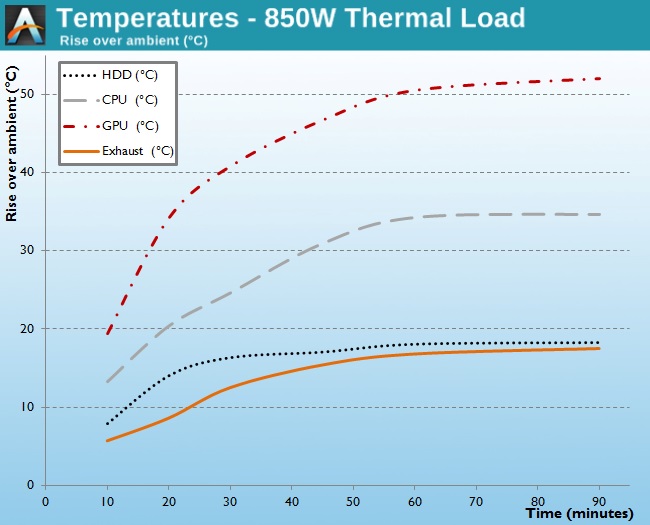
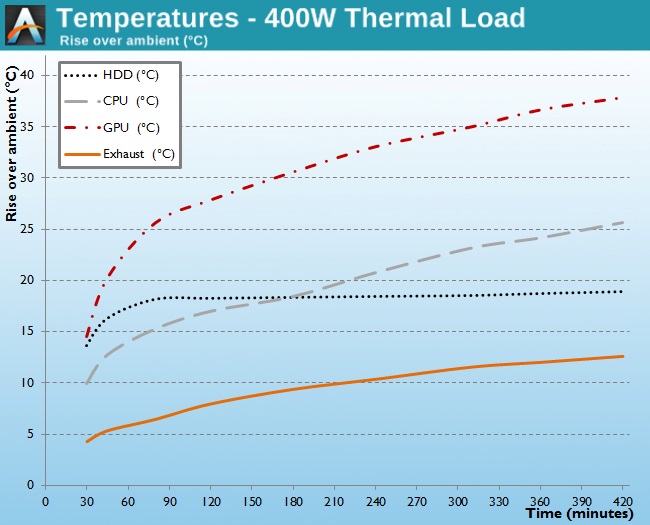
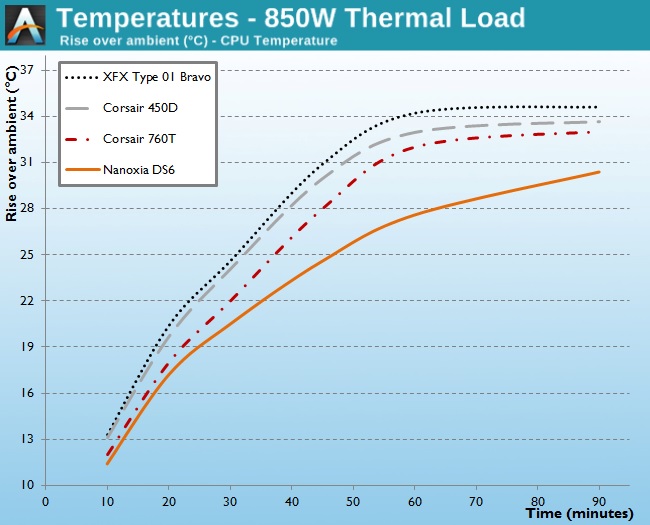
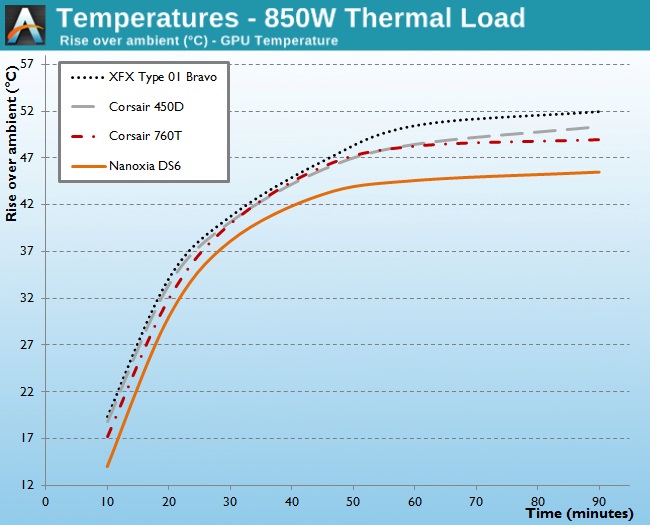
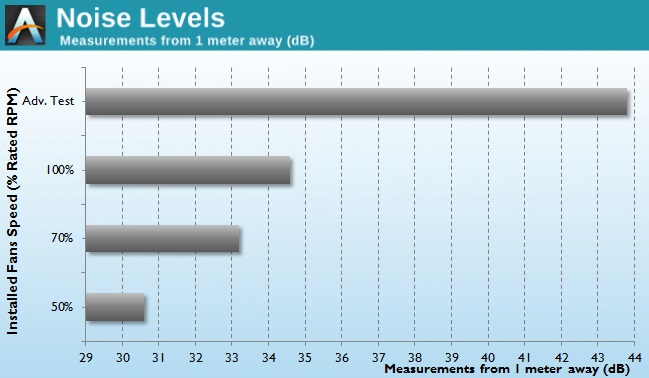








28 Comments
View All Comments
piroroadkill - Friday, May 16, 2014 - link
Another large, generic and ugly case.I want to see a lot more innovation in the arena of microATX and miniITX.
A good example of an innovative microATX case is the Aerocool DS Cube. Damn nice.
nissefar - Friday, May 16, 2014 - link
Yes. I don't get why so many mediocre mid towers keeps getting released, when that market is already saturated.For the vast majority of users, there is no need to build anything larger than mATX or even ITX. But the big producers are moving so slowly in this area, basically if you want something that's not huge and doesn't look awful you have to go for custom niche productions like the Ncase M1.
RaistlinZ - Friday, May 16, 2014 - link
Stick to video cards.sicyo - Friday, May 16, 2014 - link
I don't mind the looks but I wouldn't spend $50, let alone $130 on a case that broke so easily in a review.jmke - Friday, May 16, 2014 - link
", we mentioned that the plastic top and bottom frames are just a decoration and mishandling them will almost certainly cause permanent damage. We tested that theory by trying to lift the empty case by its rear top plastic frame, which looks like a handle. The result of that test was the snapping of the frame even before the whole case was off the ground. The bottom rear frame shattered when the case landed back on the floor as well. It goes without saying that users need to handle the Type 01 Bravo with extra care."if it looks like a handle, people will use it as a handle. make sure it can support the weight and then some. and you tried it with an empty case, imaging you installed thousands of $$$ and it breaks..
they have to fix this... either remove the handles or make the sturdy.
Good example of handles done right is Coolermaster Cosmos; that one has handles top/bottom, but they support the weight, even when loaded with 10+ HDDs!
lavaheadache - Friday, May 16, 2014 - link
what a steaming pile of garbage. I feel bad for anybody that buys that caselmcd - Friday, May 16, 2014 - link
Not only should the handles work, but the front panel should be covered by a band of thick plastic about 1/3 from the base just to improve the aesthetic (and the logo, buttons, and ports can all go there too). Below the band that I suggest they insert, HDDs should be hot-swap facing forward.Gunbuster - Friday, May 16, 2014 - link
It looks like they designed maybe 45% of the case at most and then said aw screw it just ship it out.And that grime/fingerprint magnet finish. No thanks...
Dr0id - Monday, May 19, 2014 - link
Man the grime was the first thing I noticed in the pictures. I thought my glasses were dirty.I appreciate Fyll's technical review, but the $30 looks of this case kind of sour any compliments he could give to XFX.
The whole thing looks like a cheap 80's boombox, with the front looking like the speaker grill, the grimy faded black plastic all round, and the useless rounded flare which looks like it would brake if you stare at it (but would usually be stamped with something witty like "Xtreme Bass.)
Torashin - Friday, May 16, 2014 - link
Oh god, it's hideous!